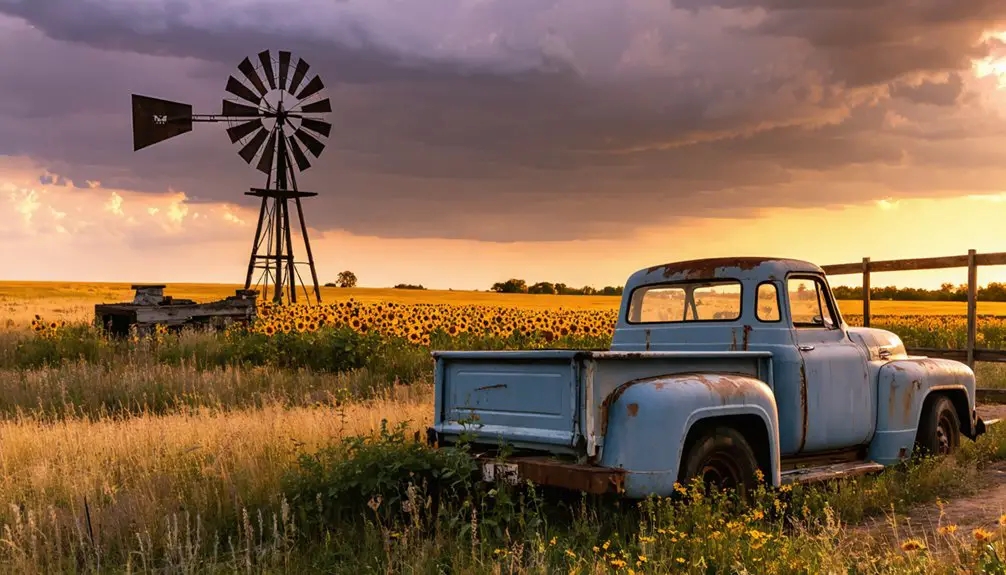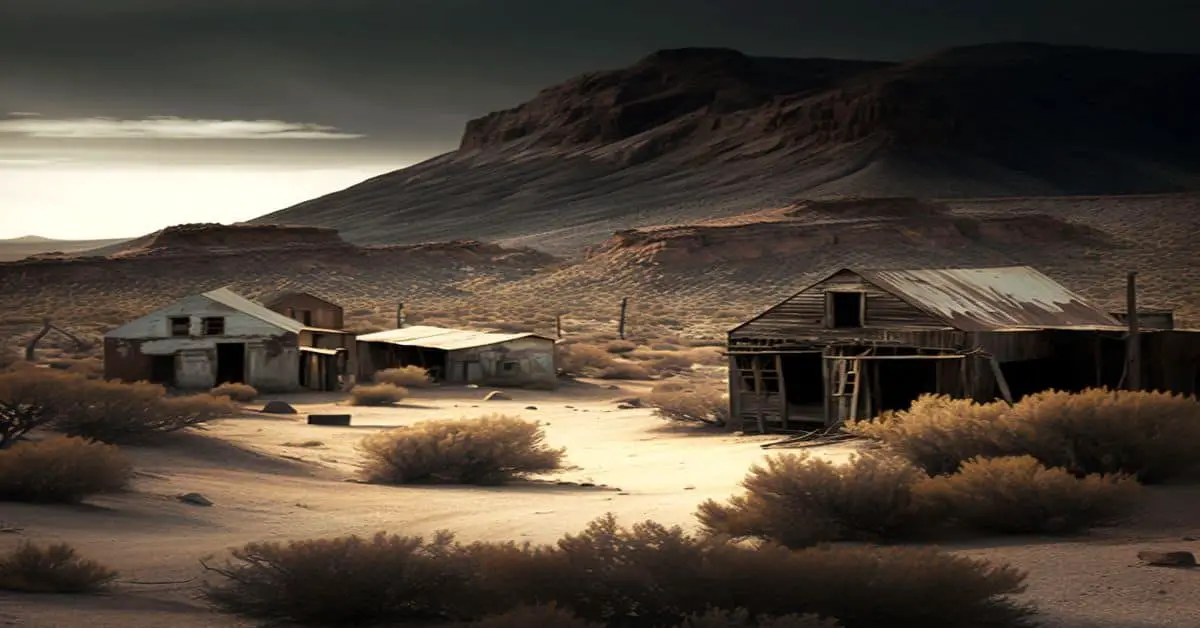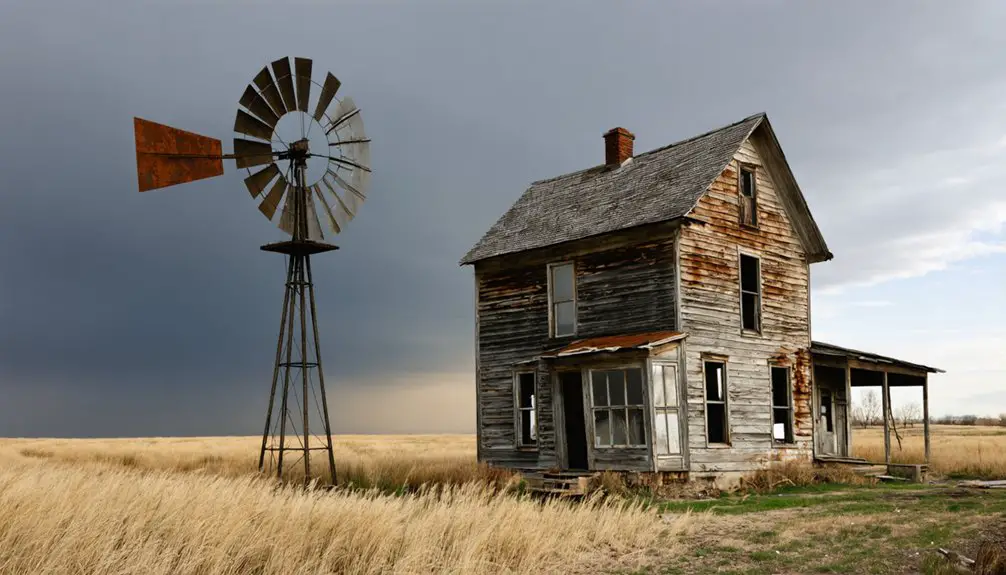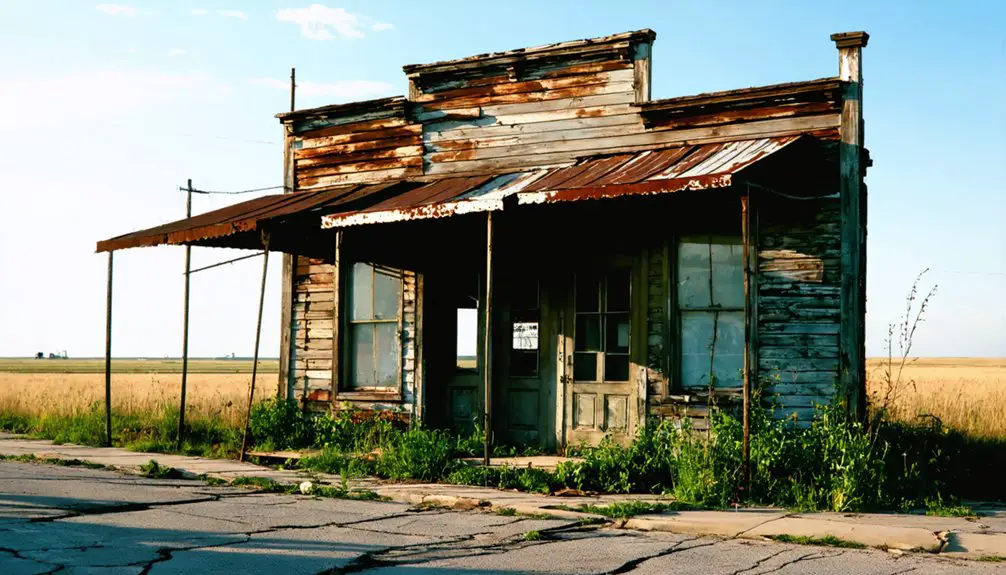You’ll find Scott’s Valley near Nebraska’s iconic Scotts Bluff, where fur trader Hiram Scott’s 1828 death left a lasting legacy. This ambitious 1880s settlement thrived briefly as an agricultural hub with grand plans for universities and civic buildings. By the early 1900s, bypassed rail routes, harsh weather, and the Great Depression led to its abandonment. Today, the ghost town‘s scattered remains and rich pioneer history paint a compelling picture of America’s westward expansion.
Key Takeaways
- Scott’s Valley was an agricultural settlement near Scotts Bluff, Nebraska, named after fur trader Hiram Scott who died there in 1828.
- The community reached its economic peak in the early 1900s but declined when railroads bypassed the area, isolating it from commerce.
- Daily life centered around farming, ranching, and trading, with residents facing harsh conditions and relying heavily on self-sufficiency.
- Despite ambitious plans for grand buildings including a seminary, the settlement became one of Nebraska’s architectural failures with no structures remaining.
- The area is now preserved as a 3,000-acre historic site with scheduled tours and partnerships supporting ongoing maintenance and restoration.
Origins of the Valley’s Name: Hiram Scott’s Legacy
Hiram Scott’s brief but impactful life as a fur trader in the American West left an indelible mark on Nebraska’s landscape. Born around 1805 in St. Charles County, Missouri, you’ll find his legacy preserved in the dramatic sandstone formations where he met his fate in 1828.
As a clerk and trapper for William Henry Ashley’s Rocky Mountain Fur Company, Scott ventured through treacherous territories, participating in fur trade rendezvous near the Great Salt Lake. Scott was present during the Arikara War of 1823, which resulted in several trader deaths. William Clark licensed the company to conduct trade with Native Americans.
His final journey ended tragically near what’s now known as Scotts Bluff, where illness led to his abandonment. You can trace his story through the North Platte River valley, where the unusually tall and muscular mountain man once traveled.
His name now graces not only the bluff but also the surrounding county and city of Scottsbluff, immortalizing his contribution to America’s western frontier.
Early Settlement and Pioneer Life
While the Astorians first passed through in 1812-1813, permanent settlement near Scotts Bluff didn’t take root until the mid-1880s when homesteaders began filing claims along the North Platte River valley.
You’d have found these early pioneers facing harsh prairie conditions as they established their homesteads, carefully balancing settlement strategies between fertile farmland access and security concerns.
Life wasn’t easy – you’d to fence your property due to herd laws enacted around 1887, manage conflicts with both cattle companies and Indigenous tribes, and survive through challenging weather conditions.
These pioneer hardships shaped daily existence, as families focused on subsistence farming and ranching. The French hunters and traders were among the first Europeans to explore the region in the late 1600s.
The region’s strategic location along major westward trails meant you’d frequently encounter emigrants heading to Oregon and California, creating a dynamic frontier community along the North Platte’s banks. The area was named after Hiram Scott, a fur trader whose remains were discovered near a spring at the bluff.
Economic Rise and Peak Years
During the late 1800s, Scott’s Valley emerged as a modest agricultural hub, with its economy centered on wheat cultivation, corn production, and cattle ranching.
You’d find pioneer families applying basic farming techniques along the Platte River, where seasonal workers helped maintain the agricultural cycle. Trading posts and supply stores served both settlers and travelers, while periodic market fairs and livestock auctions fostered economic sustainability. Like many Nebraska ghost towns, Scott’s Valley’s fate was tied to farming challenges and economic shifts. The Platte River Road had historically served as a vital route for traders and explorers moving westward.
Despite limited rail access hampering its competitive edge, the town reached its economic peak in the early 1900s.
You could witness a bustling community supported by family-owned farms, a general store, blacksmith, and post office. However, the town’s reliance on manual labor and basic infrastructure, coupled with its isolation from major railroad lines, ultimately constrained its potential for significant growth.
The Turning Point: Factors Behind Abandonment
As transportation routes shifted away from Scott’s Valley in the early 1900s, you’d witness the beginning of the town’s steady decline.
When railroads bypassed the settlement and river transport fell from favor, you’d find yourself increasingly isolated from Nebraska’s growing commerce centers.
The abandonment causes multiplied as Scott’s Valley faced the harsh realities of Great Plains life.
You’d struggle against persistent droughts, soil degradation, and unforgiving weather that made farming nearly impossible.
The economic decline accelerated during the Great Depression, forcing younger residents to seek opportunities in larger towns.
The completion of the transcontinental railroad in 1869 further diverted traffic and trade away from small settlements like Scott’s Valley.
Without new industry to replace failing farms, you’d watch as community institutions – schools, churches, and businesses – shuttered one by one.
With no economic lifeline, the once-vibrant heart of Scott’s Valley fell silent as its vital institutions vanished forever.
The outmigration of residents sealed the town’s fate, transforming it into another Nebraska ghost town.
Like many towns established in the 1880s railroad boom, Scott’s Valley suffered from being one of too many settlements placed close together.
Natural Landscape and Geographic Features
As you explore Scott’s Valley today, you’ll notice how the North Platte River carved the distinctive valley terrain, creating broad alluvial fans at the base of towering Scotts Bluff.
The limestone-capped bluff, rising 800 feet above the river valley, dominates the landscape with its layered sandstone and volcanic ash deposits dating back 22-33 million years. This geological formation covers an area of 5 square miles and serves as a prominent feature of western Nebraska. Wind and water eroded geological deposits over millions of years to create the unique features visible today.
The natural gateway of Mitchell Pass, formed between Scotts Bluff and South Bluff, considerably influenced the valley’s settlement patterns and eventual abandonment.
River Valley Terrain Details
While the North Platte River carved its path through western Nebraska’s plains, it created a distinctive river corridor marked by dramatic geological features.
You’ll find diverse river valley ecosystems spanning mixed-grass prairie, riparian zones, and rugged badlands. The terrain rises dramatically from the valley floor, where geological formations like Scotts Bluff reach 4,659 feet above sea level.
As you explore the valley, you’ll encounter sedimentary layers of sandstone, siltstone, and limestone shaped by wind and water. The hard limestone caprock crowning the bluffs has protected them from erosion, creating steep valley edges that rise up to 800 feet.
Between the river and bluffs, you’ll discover alluvial plains formed by centuries of sediment accumulation, while unique formations like Dome Rock and Eagle Rock stand as silent sentinels.
Bluff Formation Impact Analysis
The geological history of Scott’s Valley’s bluff formations spans over 70 million years, beginning with Pierre Shale deposits from an ancient inland sea.
You’ll find dramatic evidence of the region’s past in the steep, rocky faces where calcium carbonate-rich “pipy” concretions form protective caps over softer stone layers.
As you explore the valley, you’ll notice how bluff erosion has removed up to 800 feet of sedimentary rock, with ongoing sediment transport reshaping the landscape.
The northwest-tilting bedrock layers reveal distinct volcanic ash deposits from massive eruptions 33 million years ago.
These geological processes have created a unique terrain where ancient river deposits mix with wind-blown sediments, telling the story of changing climates and environments that have shaped Scott’s Valley into what you see today.
Trading Routes and Transportation Networks
Located at a critical juncture of pioneer migration routes, Scott’s Valley emerged during Nebraska’s territorial period alongside major transportation corridors like the Oregon Trail and Platte River Valley.
You’ll find evidence of early trade patterns through the nearby trading posts that connected with Native American trails and Fort Kearny’s essential supply lines.
The town’s transportation decline began as railroads reshaped Nebraska’s commerce in the late 1800s.
While stagecoach routes and rudimentary roads once linked Scott’s Valley to surrounding settlements, the town’s bypass by major rail lines proved fatal to its survival.
The closure of the local post office signaled its growing isolation from emerging transport networks.
As better-connected urban centers flourished, Scott’s Valley gradually faded into obscurity, unable to compete with rail-equipped trading hubs.
Daily Life in Scott’s Valley
In Scott’s Valley, you’d have found homesteaders facing daily challenges like hauling water from the local creek and maintaining their wooden frame houses against harsh weather conditions.
You would’ve seen families rising before dawn to tend to livestock and prepare for long days of fieldwork, often relying on neighbors’ help during vital planting and harvest seasons.
Local trading activities centered around the exchange of crops, livestock, and handcrafted goods, with residents traveling by wagon to nearby settlements when they needed supplies unavailable in the valley.
Homestead Living Challenges
Life on a Scott’s Valley homestead demanded extraordinary resilience from Nebraska’s pioneering families, who faced relentless environmental and logistical challenges during their settlement efforts.
You’d have to battle extreme prairie weather, from bitter winters to scorching summers, while managing scarce water resources and unpredictable soil conditions.
Pioneer resilience meant developing survival strategies for everything: preserving food through drying and canning, maintaining sod houses, and treating illnesses with herbal remedies when doctors were days away.
Daily life revolved around exhausting manual labor – hauling water, chopping wood, and tending to crops and livestock.
Your isolation from neighbors and larger towns meant you couldn’t count on quick help during emergencies, forcing complete self-reliance in this unforgiving Nebraska terrain.
Market and Trading Activities
While homesteaders battled daily survival challenges, Scott’s Valley‘s strategic position near major pioneer trails made it a bustling hub of commercial activity. The trading practices centered around essential exchanges between settlers, Native American tribes, and passing traders along the Platte River corridor.
You’d find these key market dynamics at work in Scott’s Valley:
- Fur trading dominated early commerce, with buffalo and beaver pelts being prime commodities.
- Agricultural goods and livestock were bartered due to limited currency circulation.
- Metal tools, firearms, and ammunition were exchanged for raw materials and food.
When you visited the trading posts, you’d encounter a mix of cultures as settlers, indigenous peoples, and merchants gathered to conduct business.
These market activities weren’t just commercial – they provided vital social connections and information exchange in an otherwise isolated frontier setting.
Notable Structures and Architecture
Scott’s Valley’s architectural legacy began modestly in the 1850s with a handful of log structures built from local timber, yet its ambitious city plans called for a sophisticated urban landscape encompassing 276 blocks.
You’ll find that while the settlement’s early buildings were basic, its founders envisioned grand educational aspirations, including a three-story brick seminary designed to house 250 students – larger than Omaha’s territorial capital building.
The town’s carefully plotted streets like Broadway and Maine were meant to connect a university, schools, town hall, and railroad depot.
Despite these elaborate plans, Scott’s Valley became one of Nebraska’s most notable architectural failures.
Today, you won’t find the impressive brick buildings or stone structures that were once dreamed of.
Preservation Efforts and Historical Records
The archaeological documentation of Scott’s Valley remains minimal, with no formal surveys or excavations recorded at the Nebraska ghost town‘s former location.
Historical records about the settlement exist primarily as scattered mentions in county transaction logs and pioneer trail accounts, while the state’s broader ghost town preservation programs haven’t prioritized this site.
You’ll find no dedicated monuments or protective measures in place, as the town’s physical remnants have largely disappeared due to agricultural development and natural weathering.
Archaeological Site Documentation
Archaeological documentation efforts at Scott’s Valley have employed sophisticated methodologies to preserve both physical artifacts and historical records spanning 12,000 years of human occupation.
Through rigorous archaeological techniques and artifact analysis, you’ll find evidence of multiple cultural periods preserved in distinct stratigraphic layers.
Key findings at the site include:
- Carbon-dated materials establishing precise chronological occupation sequences
- Lithic tools and processed faunal remains indicating hunting and settlement patterns
- Quartz crystal artifacts demonstrating advanced tool-making capabilities
The site’s documentation process follows modern CEQA guidelines, ensuring proper management of cultural resources.
You’ll see how repeated site surveys have revealed multiple occupation periods, while the integration of oral histories and pioneer accounts provides essential context for understanding the area’s rich cultural heritage.
Historical Archive Collections
Preservation initiatives across multiple historical societies have established extensive archival collections documenting Scott’s Valley’s past. You’ll find critical historical records, including tax assessments, land valuations, and early plat surveys from the 1850s and 1860s, which reveal the economic shifts that led to the town’s abandonment.
These materials highlight the historical significance of this vanished settlement.
For archival access, you can explore digitized documents through the Nebraska State Historical Society’s online platforms, which include rare photographs, maps, and scholarly articles.
Local genealogical records offer birth, marriage, and death data that connect families to this lost community. The society’s collaboration with volunteers continues to uncover and preserve additional documents, ensuring Scott’s Valley’s story remains accessible for future research and understanding.
Monument Protection Programs
Since its establishment in 1919, federal protection programs have transformed Scotts Bluff National Monument into a meticulously preserved 3,000-acre historic site.
You’ll find extensive monument preservation efforts coordinated through federal funding and state-level initiatives, ensuring this landmark’s protection for future generations.
Key preservation achievements include:
- New Deal programs that constructed the Summit Road, tunnels, and Visitor Center while maintaining historical authenticity
- Nebraska State Historic Preservation Office partnerships with local governments and Native American tribes
- Ongoing maintenance and restoration projects supported by federal funding and preservation grants
Today, you can experience the results of these protection efforts through carefully planned infrastructure that balances public access with conservation.
The monument’s status guarantees continued preservation while restricting development that could compromise its historical significance.
Modern-Day Ghost Town Tourism
While ghost towns once represented the decline of the American frontier, modern tourism has transformed these abandoned settlements into compelling destinations for history enthusiasts and adventure seekers.
At Scott’s Valley, you’ll find ghost town experiences shaped by digital-age tourism, where social media and virtual tours complement traditional exploration. Despite economic challenges affecting tourism infrastructure, you can still discover authentic remnants of the past through scheduled tours and historical reenactments.
Modern ghost towns blend digital innovation with historical authenticity, offering visitors both virtual experiences and tangible connections to the past.
The tourism impact extends beyond mere visitation – it’s reshaping how these sites survive. You’ll notice how digital documentation through YouTube videos and Instagram posts has created new ways to experience ghost towns, while responsible tourism practices help protect these historic spaces.
Local communities now balance preservation with accessibility, ensuring these windows into America’s past remain open for future generations.
Frequently Asked Questions
Were Any Notable Crimes or Mysterious Deaths Reported in Scott’s Valley?
You won’t find any documented unsolved mysteries, ghost sightings, or notable crimes in Scott’s Valley’s records. Historical research shows no evidence of mysterious deaths or criminal incidents in this Nebraska ghost town.
What Native American Tribes Originally Inhabited the Scott’s Valley Area?
Like ancient spirits across the plains, you’d find the Cheyenne, Arapaho, Sioux, Pawnee, and Crow as primary Native tribes sharing this cultural heritage, with Shoshone and Ute also claiming ancestral connections.
Did Any Famous Pioneers or Historical Figures Visit Scott’s Valley?
You won’t find documented famous visitors at this location, though pioneer stories tell of numerous unnamed emigrants passing nearby along the Oregon, California, and Mormon trails near Scotts Bluff.
What Happened to the Original Town Records and Documents?
You won’t find the original town archives today – they’ve likely been lost to time. Poor document preservation, environmental damage, and the town’s abandonment meant most records weren’t properly saved or protected.
Were There Any Local Legends or Folklore Specific to Scott’s Valley?
You won’t find documented ghost sightings or local myths specific to Scott’s Valley in historical records. While nearby towns have preserved their folklore, any unique stories from this settlement remain undiscovered.
References
- https://www.legendsofamerica.com/ne-hiramscott/
- https://kids.kiddle.co/List_of_ghost_towns_in_Nebraska
- https://www.youtube.com/watch?v=redtU6GT-BY
- https://freepages.history.rootsweb.com/~gtusa/usa/ne.htm
- https://en.wikipedia.org/wiki/List_of_ghost_towns_in_Nebraska
- https://en.wikipedia.org/wiki/Hiram_Scott
- https://history.nebraska.gov/wp-content/uploads/2017/12/doc_publications_NH1945HScott.pdf
- https://www.nps.gov/people/hiram-scott.htm
- https://www.nps.gov/parkhistory/online_books/scbl/history/chap1.htm
- https://encyclopediaofarkansas.net/entries/nebraska-scott-county-13814/



